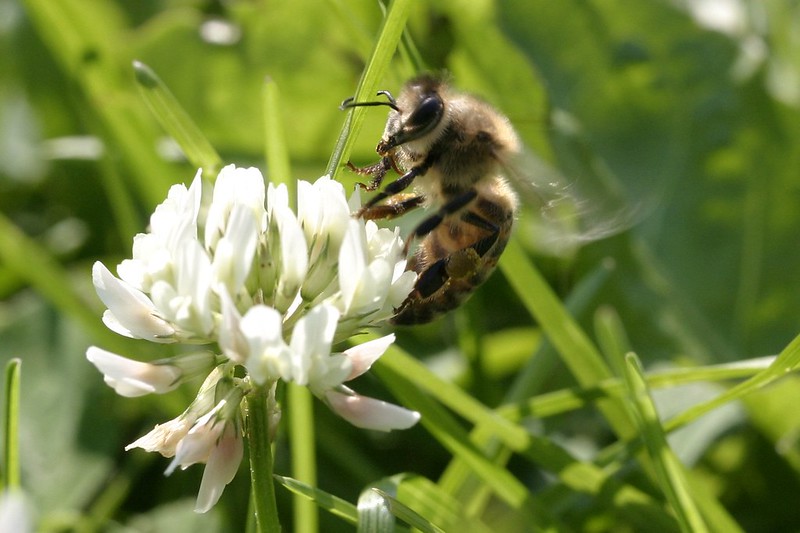
A new Biology Integration Institute featuring Kellogg Biological Station LTER researchers and data will study interactions between clover plants and their nitrogen-fixing rhizobium mutualists, and bees.
Credit: Radu Privantu via Flickr
Many ecological functions depend on symbiosis, where two organisms come together to form emergent traits neither displays alone. Microbes like bacteria and viruses are often at the center of these interactions. A new $12.5M National Science Foundation (NSF) grant will fund an ambitious endeavor to synthesize biological data across several disciplines to study the role of symbioses in evolution and ecology. Called the Genomics and Eco-evolution of Multi-scale Symbioses Biology Integration Institute (GEMS BII), the collaboration will include molecular, organismal, computational and theoretical approaches, and Kellogg Biological Station (KBS) LTER will play a key part in the project.
“The point of these Institutes is to reintegrate biology,” says Jennifer Lau, a researcher with KBS LTER who will collaborate on the GEMS project. “Scientist have become siloed, with some studying genes and cellular mechanisms and others studying whole organisms, communities, and ecosystems, orbiting in different spheres and rarely interacting.” GEMS will operate similar to LTER sites in the sense that the team will use place-based research and integrate research across subdisciplines in ecology and across different taxa to gain a more complete understanding of the functioning of communities and ecosystems. “We are focusing on a common set of interacting species to integrate across biology and understand how symbioses function from the sub-cellular level to the level of ecosystems,” explains Lau.
Researchers with the GEMS BII will study the evolution and ecological consequences of “nested symbioses” by focusing on the interactions between clover plants and their nitrogen-fixing rhizobium mutualists, and bees, which are the primary pollinators of clover in the Midwest. The project builds on a long-term nitrogen addition experiment started at KBS LTER in 1988 by Kay Gross. Lau and her collaborator Katy Heath, also affiliated with KBS, isolated rhizobium strains collected at the experiment site, and these strains will be used by the GEMS team to answer questions about symbiosis. The team will also sample additional soil and plant microbes from KBS experimental plots along with bees and their associated microbes.
The GEMS team has three key goals: one, to characterize the diversity of phenotypes and genotypes in symbioses; two, to determine what molecular and ecological characteristics lead to host-symbiont specificity and interactions; and three, to investigate how symbioses might contribute to rapid adaptation and how this adaptation might contribute to community and ecosystem responses to global change.
“The idea at the core of this work is exciting – that symbiosis is key to understanding how natural systems function,” says Heath. “Organisms in nature are connected by sometimes unnoticed symbiotic interactions, like viruses embedded in our genomes, genes that move around between species and bring new traits with them, or bacteria that are participating in different interactions depending on when and where you sample them.”
The GEMS team is working from a strong foundation of long-term data from field and lab observations. This collaboration will allow them to pull much of this data together to gain a much deeper understanding of the importance of symbioses for evolution and ecology, from the molecular all the way up to ecosystem level. “It’s rare to have a group this broad committed to working in a single local ecosystem,” says Heath. “There are some limitations that come with that, but the benefit is our ability to address the biological components from several approaches and eventually connect all those dots together.”
-Kristen Weiss










